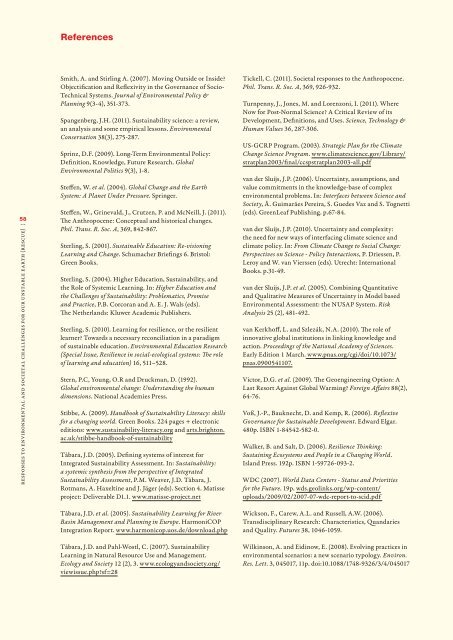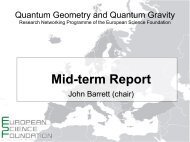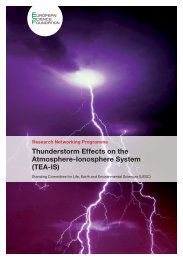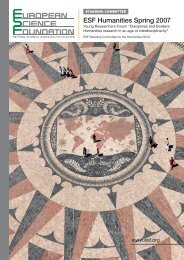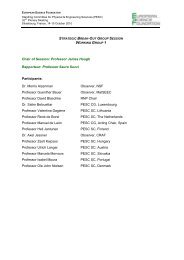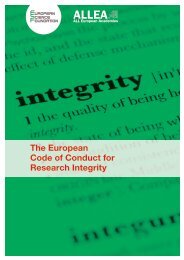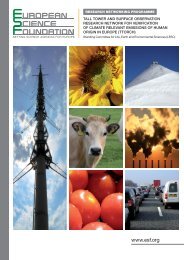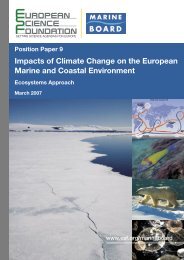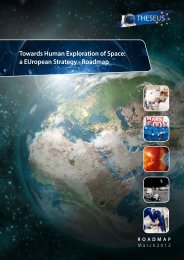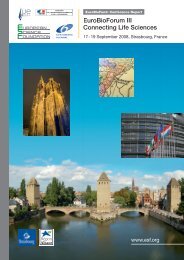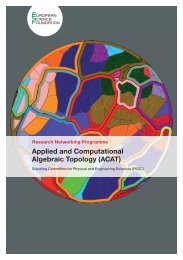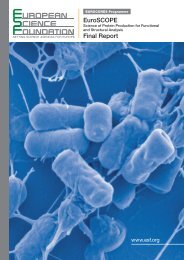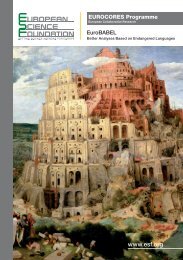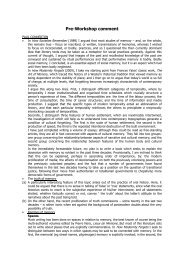Synthesis Report - European Science Foundation
Synthesis Report - European Science Foundation
Synthesis Report - European Science Foundation
You also want an ePaper? Increase the reach of your titles
YUMPU automatically turns print PDFs into web optimized ePapers that Google loves.
References58Responses to Environmental and Societal Challenges for our Unstable Earth (RESCUE)Smith, A. and Stirling A. (2007). Moving Outside or Inside?Objectification and Reflexivity in the Governance of Socio-Technical Systems. Journal of Environmental Policy &Planning 9(3-4), 351-373.Spangenberg, J.H. (2011). Sustainability science: a review,an analysis and some empirical lessons. EnvironmentalConservation 38(3), 275-287.Sprinz, D.F. (2009). Long-Term Environmental Policy:Definition, Knowledge, Future Research. GlobalEnvironmental Politics 9(3), 1-8.Steffen, W. et al. (2004). Global Change and the EarthSystem: A Planet Under Pressure. Springer.Steffen, W., Grinevald, J., Crutzen, P. and McNeill, J. (2011).The Anthropocene: Conceptual and historical changes.Phil. Trans. R. Soc. A, 369, 842-867.Sterling, S. (2001). Sustainable Education: Re-visioningLearning and Change. Schumacher Briefings 6. Bristol:Green Books.Sterling, S. (2004). Higher Education, Sustainability, andthe Role of Systemic Learning. In: Higher Education andthe Challenges of Sustainability: Problematics, Promiseand Practice, P.B. Corcoran and A. E. J. Wals (eds).The Netherlands: Kluwer Academic Publishers.Sterling, S. (2010). Learning for resilience, or the resilientlearner? Towards a necessary reconciliation in a paradigmof sustainable education. Environmental Education Research(Special Issue, Resilience in social-ecological systems: The roleof learning and education) 16, 511–528.Stern, P.C, Young, O.R and Druckman, D. (1992).Global environmental change: Understanding the humandimensions. National Academies Press.Stibbe, A. (2009). Handbook of Sustainability Literacy: skillsfor a changing world. Green Books. 224 pages + electroniceditions: www.sustainability-literacy.org and arts.brighton.ac.uk/stibbe-handbook-of-sustainabilityTàbara, J.D. (2005). Defining systems of interest forIntegrated Sustainability Assessment. In: Sustainability:a systemic synthesis from the perspective of IntegratedSustainability Assessment, P.M. Weaver, J.D. Tàbara, J.Rotmans, A. Haxeltine and J. Jäger (eds). Section 4. Matisseproject: Deliverable D1.1. www.matisse-project.netTickell, C. (2011). Societal responses to the Anthropocene.Phil. Trans. R. Soc. A, 369, 926-932.Turnpenny, J., Jones, M. and Lorenzoni, I. (2011). WhereNow for Post-Normal <strong>Science</strong>? A Critical Review of itsDevelopment, Definitions, and Uses. <strong>Science</strong>, Technology &Human Values 36, 287-306.US-GCRP Program. (2003). Strategic Plan for the ClimateChange <strong>Science</strong> Program. www.climatescience.gov/Library/stratplan2003/final/ccspstratplan2003-all.pdfvan der Sluijs, J.P. (2006). Uncertainty, assumptions, andvalue commitments in the knowledge-base of complexenvironmental problems. In: Interfaces between <strong>Science</strong> andSociety, Â. Guimarães Pereira, S. Guedes Vaz and S. Tognetti(eds). GreenLeaf Publishing. p.67-84.van der Sluijs, J.P. (2010). Uncertainty and complexity:the need for new ways of interfacing climate science andclimate policy. In: From Climate Change to Social Change:Perspectives on <strong>Science</strong> - Policy Interactions, P. Driessen, P.Leroy and W. van Vierssen (eds). Utrecht: InternationalBooks. p.31-49.van der Sluijs, J.P. et al. (2005). Combining Quantitativeand Qualitative Measures of Uncertainty in Model basedEnvironmental Assessment: the NUSAP System. RiskAnalysis 25 (2), 481-492.van Kerkhoff, L. and Szlezák, N.A. (2010). The role ofinnovative global institutions in linking knowledge andaction. Proceedings of the National Academy of <strong>Science</strong>s.Early Edition 1 March. www.pnas.org/cgi/doi/10.1073/pnas.0900541107.Victor, D.G. et al. (2009). The Geoengineering Option: ALast Resort Against Global Warming? Foreign Affairs 88(2),64-76.Voß, J.-P., Bauknecht, D. and Kemp, R. (2006). ReflexiveGovernance for Sustainable Development. Edward Elgar.480p. ISBN 1-84542-582-0.Walker, B. and Salt, D. (2006). Resilience Thinking:Sustaining Ecosystems and People in a Changing World.Island Press. 192p. ISBN 1-59726-093-2.WDC (2007). World Data Centers - Status and Prioritiesfor the Future. 19p. wds.geolinks.org/wp-content/uploads/2009/02/2007-07-wdc-report-to-scid.pdfTàbara, J.D. et al. (2005). Sustainability Learning for RiverBasin Management and Planning in Europe. HarmoniCOPIntegration <strong>Report</strong>. www.harmonicop.uos.de/download.phpTàbara, J.D. and Pahl-Wostl, C. (2007). SustainabilityLearning in Natural Resource Use and Management.Ecology and Society 12 (2), 3. www.ecologyandsociety.org/viewissue.php?sf=28Wickson, F., Carew, A.L. and Russell, A.W. (2006).Transdisciplinary Research: Characteristics, Quandariesand Quality. Futures 38, 1046-1059.Wilkinson, A. and Eidinow, E. (2008). Evolving practices inenvironmental scenarios: a new scenario typology. Environ.Res. Lett. 3, 045017, 11p. doi:10.1088/1748-9326/3/4/045017


